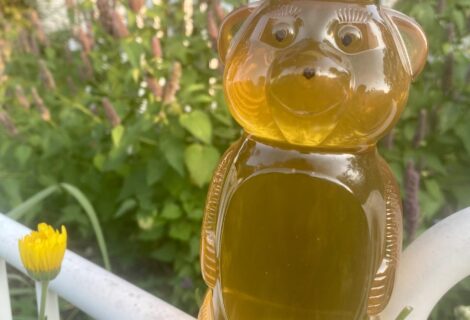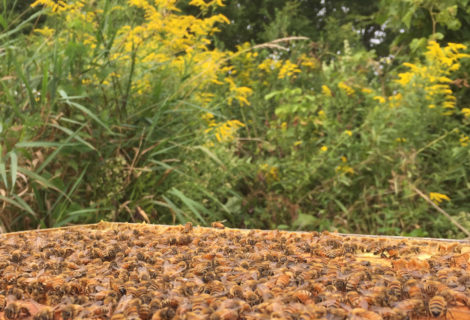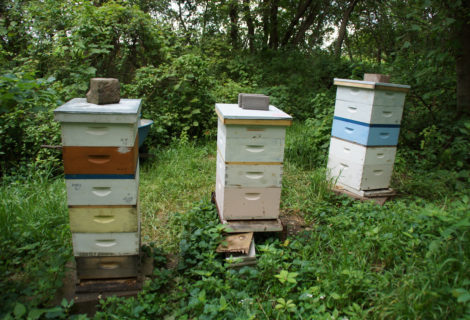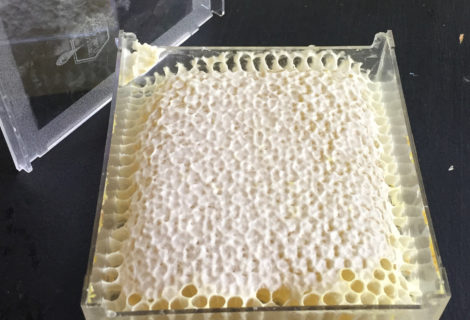Extraction Day Recap
August 19 was Honey Day this year – the day we spin out the main chunk of honey. We did some earlier quick posts on FB of harvesting the honey from the hives, which is a different sort of excitement 🙂
Every year it seems we try something a little different for warming the honey so that it flows better – out of the comb, out of the extractor, and through the filters. This year, we decided to put the honey in our back porch several days prior to extraction. Here are the 21 supers waiting to go, after doing a trial run with one of the supers. We have windows on 3 sides of the porch and if sun is shining, it can get downright hot in there.
And it worked pretty well, certainly better than the warming tents we have tried so far in the garage. The only thing that didn’t cooperate were the Canadian wildfires making the sunshine hazier than normal. But I kept some space heaters going in the porch, especially at night, and rotated the supers once – top to bottom. A couple days of 95+ degF temps in there made the honey flow pretty good.
An exciting this for us this year, was new honey spinning equipment for Our Bright Acres. I looked at a number of different extractors and uncappers, and for our budgeted price price point, I really liked a couple products from the Lega company (Italy). We worked through Blue Sky Bee Supply to purchase and ship these items. Here’s the extractor:
 It’s actually a hand crank, 15 frame, radial. Below, you can see frames loaded in it from the top.
It’s actually a hand crank, 15 frame, radial. Below, you can see frames loaded in it from the top.
You might think that it would get old and tiring really fast, hand-cranking out 270 frames of honey. But not really – it is nicely geared and the basket spins easily. The tricky part, with any extractor is loading the frames so that they are somewhat balanced. Otherwise, imagine a washing machine that is severely out of balance when it spins out a heavy load of laundry. My dad, Clair Pecinovsky, quickly became an expert at loading and balancing the extractor. We also had it screwed down to a 3/4 inch thick piece of OSB with cinder blocks on top, which really helped to stabilize it.
A few more advantages: (1) it is quiet – no loud whining DC motor, so that we can enjoy the team’s company, (2) We have room to grow. We only did 10 frames at a time because that is all we had room for in a 5-gal pail with a deep filter. You can readily get 3.5 gallons of honey out of 10 nice frames. With a slightly different system, we’ll be able to add 5 more frames at a time. (3) The basket can spin 5 frames tangentially if needed. A radial placement of frames is like spokes on a wheel, while tangential would be perpendicular to that. Tangential is more efficient at getting the honey out of a frame, given an equal spin speed, so for tough frames or cooler honey that doesn’t flow as easy, this really came in handy. The downside is that you can only do 5 tangential frames at a time, you have to flip them over manually to spin out the opposing side of the frames, and the centrifugal force against the baskets outer walls can damage the comb a bit more.
The other major piece of new equipment was the Lega Roll, that used closely spaced (and opposing) cylinders of nylons “knives” to slice the honey cappings. This is instead of uncapping each frame with a hot knife as we have done all previous years. It’s kind of big deal. It means there is no “uncapping honey” and no honey going into the extractor that has touched a hot-knife and “burned out” any nutrients in those drops of honey. Here is a side view of the machine in action:
Place the frame on top of the rollers, then pull down on the handle and the frame is pushed through the rollers which slice through each row of honeycomb cells, so that the honey can now escape. The machine could stage 10 frames on its output arm, which was perfect for the number we were extracting per spin. In order to have the honey extract out smoother, we would often use the following simple, roller device – to pull open the cappings a bit more, especially in areas of the frame that were uneven.
It did not take a whole lot of extra time to run this around one the frame and then it immediately would go into the extractor.
Flowing out of the extractor, the honey would go through the first filter or filter set, just to get out the bigger chunks of wax. After each spin, the pail of honey would be moved to the bottling table. There, the top pail would be gated into the bottom pail with a finer filter at the top. For this type of process, filtering is fairly important because there is a lot more wax coming through with the honey when a hot knife is not used. Also, we are immediately bottling, rather than using a large settling tank to give time for the wax to float to the top.
We jar the honey out of the gate of the bottom pail.
From here, the jars were taken to the shelves, where they were organized and labeled (some of them).
Yeah, that’s a lot of honey 🙂 Throughout this process, there was a critical step going on behind the scenes in the house. The filters would get clogged up with wax and would have to be cleaned with boiling water before being put back into circulation. Grandma Marilyn Pecinovsky handled that in stride – along with watching the kids, cooking our meal, taking pictures, and making sure everyone was well hydrated and taken care of!
Is there more? Oh, yes! Sometimes, we would come across a comb honey frame in a super – kind of surprise ‘easter egg’. These frames don’t have a stiff foundation, instead it is just a beeswax foundation and it does not go into the extractor. We had fun cutting out some different shapes of comb honey.
We had a lot of special help that we are very thankful for – Bob & Wendy Speary (and kids), Grace Barnhart, Moses & Brigitte, Roger and Shirley Schutz, Marilyn and Clair Pecinovsky. And the day was made more special with the addition of an extra spin-out session we did at the end for Nancy Salvo. She is recently widowed and her late husband had a couple hives on their property that were really doing well. My dad and I went out there in the afternoon while everyone else continued with the honey spinning to collect six honey supers that I arranged “bee escapes” for the day prior. We brought them back and were able to spin those out for Nancy as well.
What a great day! Praise God! Thanks to Moses and Mom for taking many of the photos in this post. Oh, and not to leave out the bees – there were lots of interactions with them surrounding this time as well. Cousins James and Grace came later in the week and we suited up to find the queen in a new colony split.
Yup, that’s a stinger in your glove, Grace. Time to close up the hive. Although we didn’t find the queen then, I eventually spotted her two days later.
From an old Jewish prayer, substituting ‘honey’ for bread.
“Blessed are You, LORD our God, King of the universe, Who brings forth [honey] from the earth.”

























Recent Comments